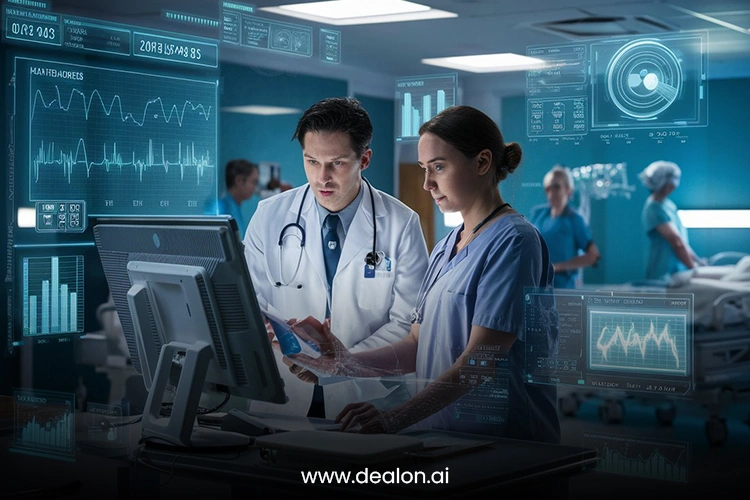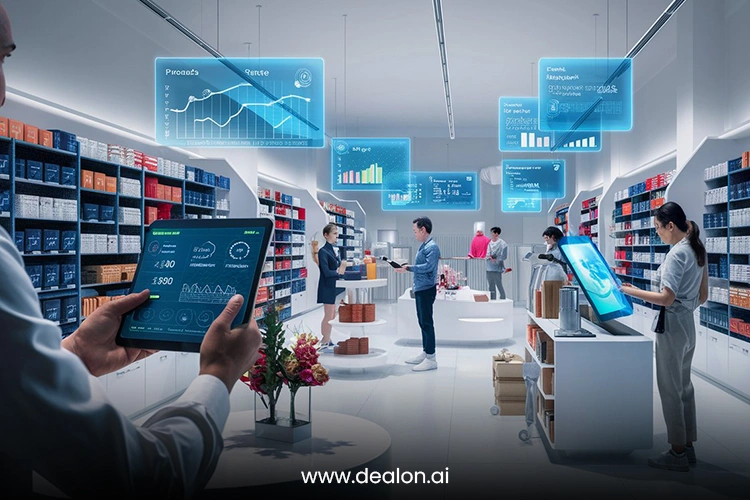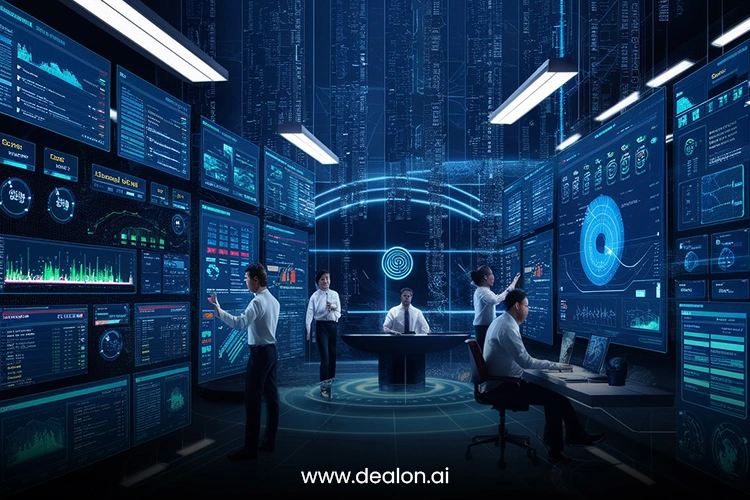AI and predictive analytics have become incredibly transformative in the age of big data. Because handling vast data is difficult for businesses, AI’s tools for analysis and promoting informed decision-making have brought new opportunities. Today’s businesses rely on predictive analytics, which combines old data and numbers to foresee the outcomes of future actions. But when AI is involved, predictive analytics can accurately predict events and behaviors that are seldom possible to project with certainty.
Unlike standard data interpretation, AI-driven analytics detects hidden trends, finds links between different aspects and predicts outcomes happening now or shortly. With this combination, organizations can respond to what is happening in the market and prepare for changes. Applying ML and deep learning to algorithms helps businesses create models that improve with experience and deliver better predictions.
AI plays a role in predictive analytics for many industries, such as healthcare, determining patient health and finance, and tracking the stock market. AI helps retailers learn about customers’ choices, leading to more-suited marketing campaigns and better shopping experiences. In this way, predictive maintenance in manufacturing foresees possible breakdowns, which minimizes periods when equipment is not working and enhances efficiency.
Also Read: 5 Trends in Natural Language Processing (NLP) Revolutionizing AI in 2025
Healthcare: Helping Health Professionals to Forecast Patient Condition

Healthcare was changed significantly when Artificial Intelligence (AI) and advanced analytics were used, especially for predicting patient outcomes and improving how we treat patients. With access to a lot of patient data from the past, AI systems combined with powerful analytics can reliably predict how a disease will progress, the chances of the patient requiring readmission, and possible effects from treatments. Because of these predictive insights through AI and analytics, healthcare providers can spot at-risk patients and offer help sooner, enhancing patient outcomes and efficiency in healthcare delivery.
AI and data analytics are helpful because they can process and understand large amounts of data, including EHRs, test outcomes, demographics, and people’s routines. In this way, machine learning (ML) algorithms use analytics to check a patient’s history and heart and blood sugar profile to predict the risk of developing heart disease or diabetes. Predicting health outcomes through AI-driven analytics allows healthcare workers to advise patients on what changes to make, such as improvements in lifestyle, when to get screened, and which treatments are best for them, decreasing the risk of severe health-related disorders.
Doctors depend on AI and predictive analytics to forecast complication rates during or after surgical procedures. By examining surgical data and patient stats through sophisticated analytics, AI can detect risks of infections, bleeding, or organ problems and alert the team promptly. It decreases the chances of complications after surgery, helps hospitals use their resources efficiently, saves money, and improves patient treatment.
AI-powered analytics can predict whether or not a patient is likely to be readmitted. AI learns how likely a patient will be admitted again to a hospital and alerts doctors so that they can take steps to manage the patient’s care once they leave the hospital. Because of early detection through advanced analytics, people get better treatment, and healthcare becomes more personal and efficient.
Personal Shopping and Inventory Management in Retail

Thanks to AI-powered predictive analytics, businesses in retail handle consumers better and become more efficient in their systems. An analysis of extensive consumer data allows AI algorithms to understand customers’ preferences, ways of shopping, and growing trends, which helps retailers offer personalized experiences. This way of customizing services makes customers feel good, stay loyal, and sell more.
A primary benefit of AI in retail is that it can learn what people like and recommend products suited to them. AI analyzes a customer’s history, what they have purchased and even their internet searches to know what they might want in the future. By doing this, platforms increase engagement and make customers feel more valued, encouraging them to return.
AI does more than engage customers; it significantly impacts managing products and supplies. With predictive analytics, retailers can accurately predict how many products will be bought. Mechanisms using AI can tell which products will stand out in greater demand when specific promotions or seasons are involved. Because of this, retailers can keep popular products in stock and prevent carrying too much inventory.
Thanks to AI, it can be predicted that certain clothing items will be on everyone’s shopping list before a holiday and that one specific tech item will soon be very popular because of the trend. Ensuring enough stock on hand lets retailers avoid shortages, better serve their customers, and boost sales efficiency, resulting in a more agile retail store.
Using Technology to Track Fraud and Manage Financial Risks

Financial institutions use AI-driven predictive analytics more often to handle fraud and riskier situations, which help ensure their integrity and safety. Machine learning (ML) algorithms, because they process data very quickly, are driving this significant change. Examining transaction information and identifying little differences, AI models can predict fraud and stop it from causing bigger harm to people and businesses.
AI is very effective in fraud detection by picking out behaviors that are not usual for a particular account. Credit card firms use predictive analytics to detect unusual activities that could indicate fraud, such as buying things in places they rarely visit or buying items far from their typical preferences. AI uses past transaction records and things like the time and place of a transaction to determine if fraud may have occurred quickly. Thanks to this method, financial institutions can catch suspicious activities rapidly, which helps stop unauthorized transactions almost immediately, saving losses.
In addition to stopping fraud, AI is key to risk management activities. These models examine financial risks, such as credit risk, by looking at previous financial actions of the borrower and foreseeing their chance of repayment. Unlike standard scores, modern AI systems in credit scoring also use information about social habits, economic factors, and other alternative forms of data. As a result, lenders can choose wisely about lending money, approving mortgages and making investments, which helps decrease the chance of a financial crash.
Artificial Intelligence for Monitoring and Upgrading Production Line Machines
AI-driven predictive analytics is transforming manufacturing by significantly reducing both maintenance needs and production downtime. If manufacturers use real-time data analysis and machine learning, they can predict equipment breakdowns and stop them before making production pause. If a machine breaks down, preventing it from causing significant problems and costly repairs is necessary.
With predictive maintenance, data from sensors in the equipment allows monitoring of the machine’s temperature, vibration, and pressure. AI is used to review the data and identify any patterns that might mean there’s a failure. Suppose the motor shows signs of vibration that are outside the typical specifications. In this situation, AI might detect that the motor is in danger of stopping, encouraging engineers to fix it before a breakdown. Using this approach decreases unplanned downtime, expensive machinery lasts longer, maintenance costs go down, and the efficiency of all equipment is improved (OEE).
Besides maintenance, AI-powered predictive analytics is key to optimizing how products are made. AI can study previous demands and use them to guide when and how much to produce in the future. This allows resources like labor and materials to be shared efficiently and keep the production lines active. AI supports better inventory management by predicting raw material and finished product levels, reducing the chance of running out of stock or having too much stock.
Combining predictive maintenance with AI production optimization ensures the production process is smooth, efficient, and inexpensive, boosting productivity and making the company more competitive.
Efficient Transportation and Predictive Delay Management for People and Goods
AI-powered predictive analytics are preparing significant changes in the logistics, ride-sharing, and management of traffic sectors. With AI processing a lot of past and current information, it can forecast where traffic will be busy, determine likely places of congestion, and predict possible road closures or accidents so all can avoid delays. Enhancing efficient workflows, optimizing customer satisfaction and overall lower expenses are benefits of incorporating AI into the transportation business.
Lyft, Uber, and other ride-sharing companies rely on AI to forecast ride demand and assign drivers properly as the day progresses. AI systems expect high ride demand by examining observed weather, traffic, scheduled events, and past usage and then arranging for enough drivers. By doing this, those who use Uber cars can expect help soon, even when work and travel are high, which further improves the service and helps drivers meet more requests.
Routes are now better planned with the help of AI, which has changed the efficiency of logistics and delivery. AI reviews traffic, forecasts, and GPS data to find the best path for delivering goods or products. As a result, employees spend less time moving to different places and use less fuel, so the company improves its budget. For example, predictive analytics may find the best delivery times so trucks are kept efficient and not delayed by traffic and routes. If companies estimate when traffic will occur and potential hold-ups, they can plan new routes, improve the delivery process, and raise the performance of their supply chains.
Also, cities can better manage traffic using AI to alter signals and modify current traffic flows to avoid jamming. As a result, road accidents are less likely, trips take less time, and less pollution is produced, benefiting everyone and companies. Thanks to AI, transporting products and passengers is now more intelligent, quicker, and environmentally friendly.
Energy: Projecting Use and Handling Supply
Adding AI to analytics has allowed energy companies to guess people’s electric needs and better manage resources. After researching earlier climate, current trends, and market behavior, AI systems give helpful advice on predicted energy demand down the road. It enables power companies to plan activities, manage costs, and become more productive so resources are appropriately shared without shortages or surpluses.
Preparing for energy consumption is particularly important during some events, and AI is crucial. An example is that AI can help predict that spikes in electricity usage will happen during hot summers when air conditioners are on or in cold seasons when people use their heaters a lot. Because of these patterns, AI allows energy firms to plan their supplies, avoiding emergencies without electricity, water, or natural gas. If providers can forecast changes in demand, consumers are motivated to change their energy usage, leading to better grid functioning and lower costs.
As well as predicting consumption trends, predictive analytics can be used for infrastructure maintenance. AI can monitor data from energy grids, pipelines, and other assets at all times, which allows it to find issues such as broken equipment or indications that parts are beginning to wear out. If the equipment is expected to fail, energy providers can plan repair tasks during off-peak times, which is less expensive and improves system reliability.
How Sports Enhance Teamwork and Boost Fan Engagement
Sports organizations increasingly turn to AI-powered predictive analytics, which gives them practical ways to boost their teams’ results and connect better with their fans. AI uses player data, past injuries, conditions on the field, and the weather to help players and coaches understand how the match might go.
AI is mainly used in sports to make athletes perform better. Using predictive analytics, individual performance can be predicted by considering what has happened before, the player’s current level of play, and outside elements such as who the rival is or the conditions during the match. By reviewing historical information, AI helps coaches determine the best ways for their team to face certain opponents and set strategies more easily. Thanks to AI, patterns in how people move or play can be recognized, which can help prevent injuries. Because of this information, teams can correct their workouts, watch over injuries, and avoid overtraining, which benefits players’ health and ongoing performance.
Besides teamwork, AI is being adopted to boost how fans connect with sports. Artificial intelligence analyzes social media, how many people attend events, and what fans like to predict which games or events are most favorite. Teams and sponsors can use the information from people’s experiences to design better marketing and promotions that excite more people about attending. AI plays a role in giving fans personalized experiences, which include specific content, recommendation engines, and interactive tools that retain their interest and keep them interested.
Conclusion
AI-based predictive analytics is essential in multiple industries, leading to new advancements and better decision-making. Because AI can analyze lots of data and make predictions, it influences how companies run their operations and connect with people.
AI contributes to patient well-being in healthcare by anticipating health issues and developing suitable treatment approaches. In finance, detecting fraud and overseeing risk control makes it more straightforward. Firms in retail use advanced data analysis to customize shopping for each person and optimize stock levels. At the same time, energy companies look to AI to predict how energy will be used and handle supplies better.
AI is also present in sports, boosting how teams play, anticipating when injuries might occur, and making fans enjoy the games more. AI allows teams to improve their plans and achieve better future results by studying the data about players and predicting matches. AI also creates marketing strategies that attract supporters and help gain their loyalty, which makes fans feel more connected.
With AI progress, businesses will rely more on predictive analytics for improved observations, workflow, and personalized experiences. Applying AI in organizations gives them a competitive edge and supports significant changes affectingaffect entire industries.

